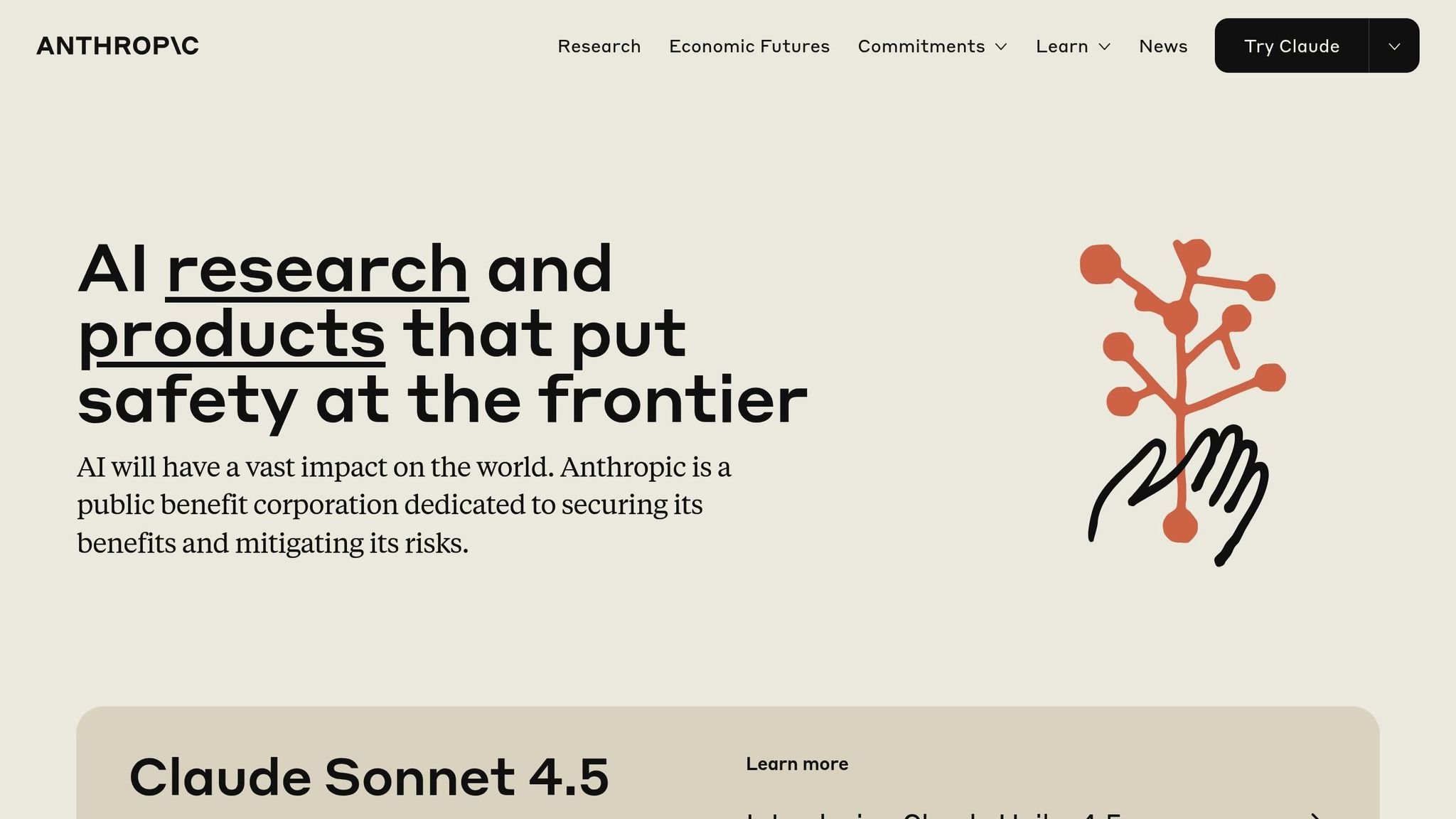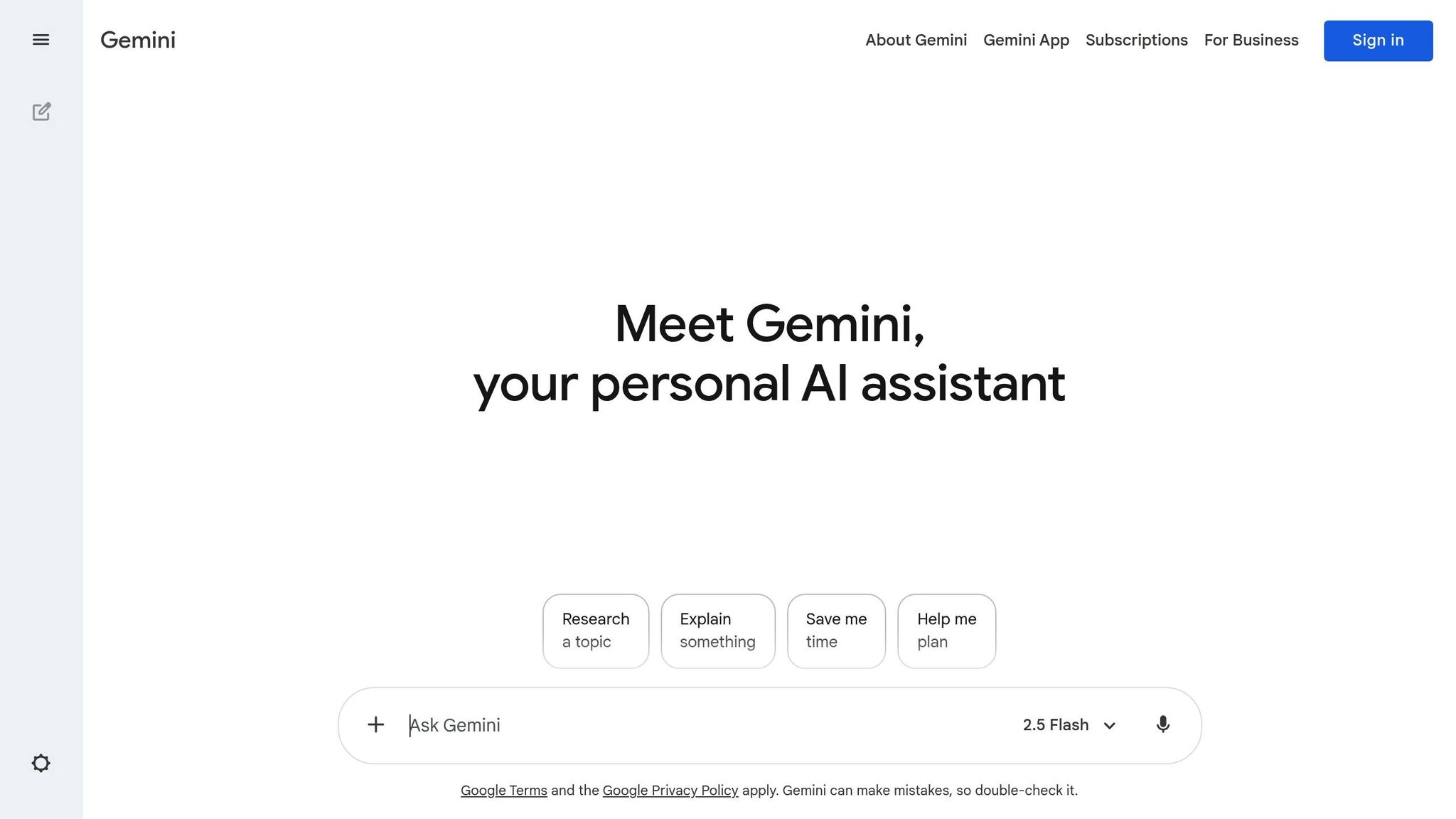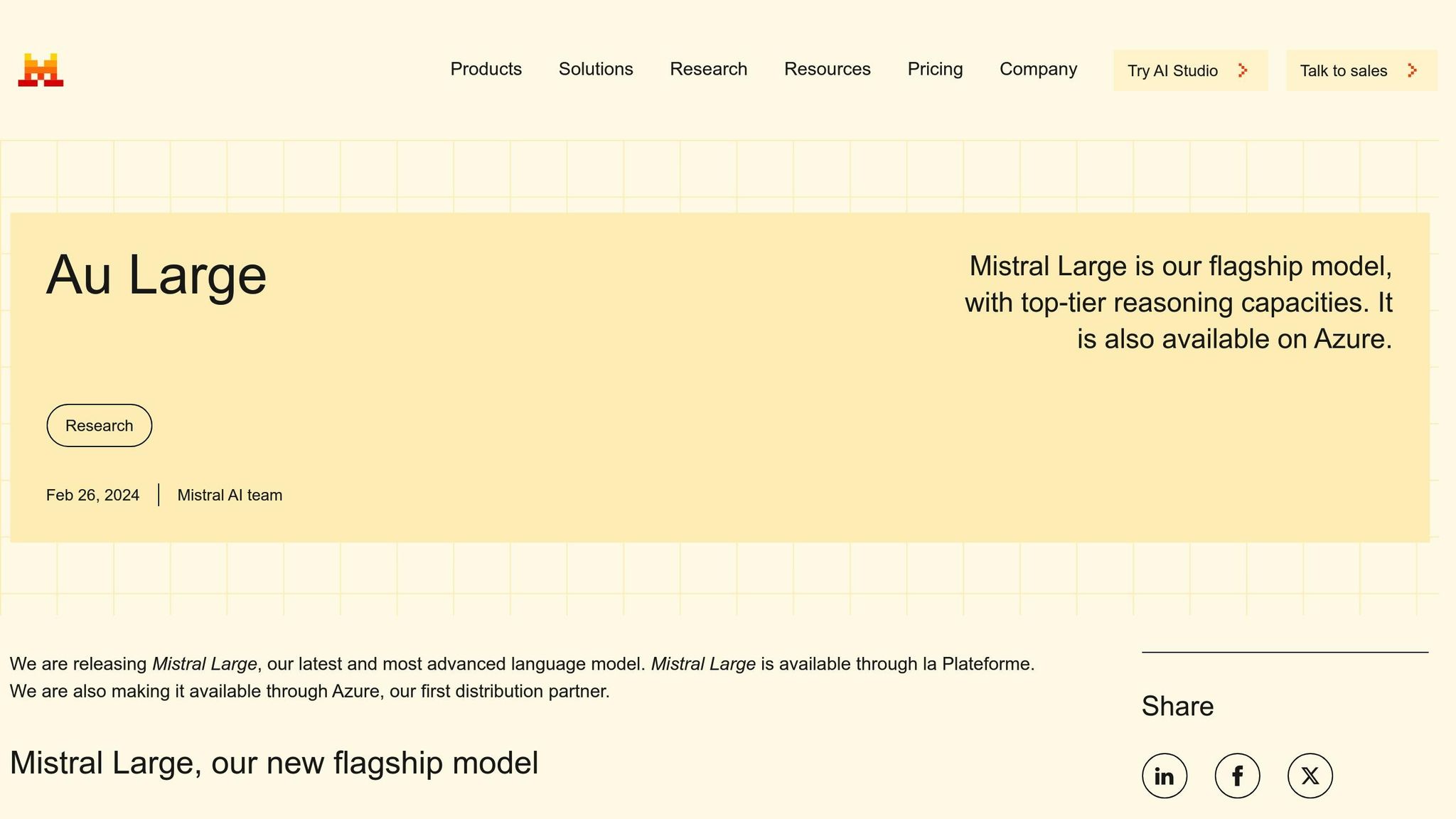
AI language models are transforming business operations by automating workflows, enhancing customer support, and streamlining content creation. With advancements in natural language processing, businesses can now handle complex tasks more efficiently. However, challenges like integration issues and unclear costs remain key concerns. Here’s a quick look at the top models expected to lead in 2026:
| Model | Key Features | Drawbacks |
|---|---|---|
| GPT-5 | Advanced reasoning, multimodal support | High cost, resource-intensive |
| Claude 3.5 Sonnet | Safety-focused, reliable code analysis | Limited availability |
| Google Gemini 2.5 Pro | Google Workspace integration, multimodal | Reliance on Google ecosystem |
| Meta LLaMA 4 | Open-source, customizable, cost-efficient | Requires technical expertise |
| Mistral Large 2 | Unknown potential | Lack of detailed information |
Each model caters to specific business needs. Companies with strong IT capabilities may prefer Meta LLaMA 4, while those already using Google tools might lean toward Gemini 2.5 Pro. For safety-critical industries, Claude 3.5 Sonnet stands out. Selecting the right model depends on aligning features with your goals and resources.

OpenAI's GPT-5 is expected to push the boundaries of language model technology for businesses. While specifics regarding its performance, integration capabilities, cost-effectiveness, and compliance features haven't been officially disclosed, the anticipation surrounding its release suggests it could significantly improve business operations. Stay tuned for more insights about other models poised to reshape business workflows in 2026.

Anthropic's Claude 3.5 Sonnet uses advanced natural language processing to simplify tasks like workflow automation, customer support, and content creation in business environments. It shines in optimizing customer service and automating content generation, making it a valuable addition to existing business operations. Similar to GPT-5, Claude 3.5 Sonnet offers distinct capabilities that enrich the evolving world of AI-powered business solutions.

Google Gemini 2.5 Pro is a powerful AI language model designed by Google to meet the demands of enterprise users. Known for its ability to handle multimodal processing and support real-time collaboration, this tool integrates effortlessly with Google Workspace and a variety of third-party platforms. It simplifies workflow automation and content creation, making it a practical choice for businesses looking to incorporate AI into their existing systems without disruption.
This model shines in tackling complex reasoning tasks and delivers reliable performance in large-scale document processing, financial analysis, and cross-departmental communication. With its scalable design and focus on efficiency, Gemini 2.5 Pro addresses the growing need for integrated and budget-friendly AI solutions in the business world.

Meta LLaMA 4 stands out as an open-source AI language model, designed with transparency and adaptability in mind. Its flexibility allows businesses to fine-tune the model for specific requirements, giving them greater control over how it's deployed and managed.
Built for extended conversations, Meta LLaMA 4 maintains a consistent tone and supports multiple languages, making it a strong choice for businesses operating in diverse markets.
Meta LLaMA 4 excels in tasks like document analysis and customer support, holding context effectively through multi-step interactions. Its training on a wide range of datasets equips it to understand and use industry-specific terminology across fields such as healthcare, finance, legal, and manufacturing.
The open-source framework of Meta LLaMA 4 ensures flexibility in deployment and scaling. Businesses can run the model on-premises, addressing data residency and regulatory needs, while also integrating it seamlessly with existing systems using standard APIs. The model supports containerized deployments through tools like Docker and Kubernetes, and its design works across various hardware setups - from single GPUs for smaller operations to distributed clusters for enterprise-scale demands.
Meta LLaMA 4’s open-source licensing eliminates per-token costs, providing a predictable and scalable cost structure for high-volume AI tasks. Organizations can manage operational expenses by running the model on their existing cloud infrastructure or on-premises servers.
With a strong focus on transparency, Meta LLaMA 4 enables businesses to audit decision-making processes, customize safety protocols, and ensure compliance with regulations like GDPR, HIPAA, and SOX. Hosting the model within an organization’s infrastructure further supports data sovereignty and security requirements.
Meta LLaMA 4 integrates text, image, and structured data workflows, making it a versatile tool for tasks like document analysis and product catalog management. It also offers capabilities for code generation and review, which are valuable for software development and IT teams. For content creation, the model ensures brand voice consistency across formats while adapting outputs to specific guidelines. This broad functionality makes Meta LLaMA 4 a powerful, cost-effective solution for businesses seeking integrated AI tools.

Details about Mistral Large 2 remain under wraps, with no confirmed information on its features, performance, integration capabilities, or compliance standards. However, early reports hint at possible advancements. This evolving model reflects the rapid progress in AI language tools for businesses, making it essential to stay tuned for updates. As more information is released, its potential impact on seamless AI workflows will become clearer.
Each AI model brings its own strengths and challenges to the table, making them suited to different business needs.
GPT-5 offers advanced reasoning and multimodal processing, making it a standout for tasks requiring detailed analysis. However, its high costs may put it out of reach for smaller businesses aiming to scale their AI capabilities.
Claude 3.5 Sonnet is known for its strong safety features and dependable code analysis, providing reliable content generation with minimized risks. On the downside, its limited availability compared to other models can make access difficult for some organizations.
Gemini 2.5 Pro integrates effortlessly with Google Workspace, making it an excellent option for companies already embedded in Google's ecosystem. Its competitive pricing is appealing to budget-conscious businesses. That said, companies outside the Google ecosystem may find themselves overly reliant on a single platform.
LLaMA 4 offers the flexibility of open-source customization and deep configurability, but it requires significant technical expertise and infrastructure, which could be a barrier for some organizations.
Mistral Large 2 remains a bit of a mystery, as its specific strengths and weaknesses haven't been fully disclosed. This lack of clarity makes it challenging for businesses to plan around its implementation or allocate budgets effectively.
Here’s a quick comparison of the models' key advantages and drawbacks:
| Model | Key Advantages | Primary Disadvantages |
|---|---|---|
| GPT-5 | Advanced reasoning, multimodal capabilities, versatile business applications | High cost, resource-heavy implementation |
| Claude 3.5 Sonnet | Strong safety features, reliable code analysis | Limited availability, fewer integration options |
| Gemini 2.5 Pro | Seamless Google Workspace integration, competitive pricing | Reliance on a single platform |
| LLaMA 4 | Open-source flexibility, extensive customization options | Requires technical expertise, significant infrastructure investment |
| Mistral Large 2 | Unknown potential benefits | Lack of detailed information, uncertain capabilities |
Choosing the right model depends on a company’s specific needs, budget, and technical resources. Organizations with strong IT expertise might lean toward the customizable nature of LLaMA 4, while those seeking simplicity and cost efficiency may prefer Gemini 2.5 Pro. For industries requiring strong safety measures - like those handling sensitive data - Claude 3.5 Sonnet often stands out. These considerations highlight the importance of aligning AI solutions with operational goals and resource availability.
By 2026, AI language models are delivering tailored solutions that cater to diverse business needs. GPT-5 stands out for its advanced reasoning and content generation, while Claude 3.5 Sonnet is a strong choice for safety-critical tasks. Gemini 2.5 Pro shines with its multimodal capabilities, LLaMA 4 offers open-source adaptability, and Mistral Large 2 provides a cost-efficient option through its mixture-of-experts design.
The success of AI adoption hinges on aligning model capabilities with specific business goals. For industries with strict regulatory requirements, Claude's compliance features are invaluable. Companies looking for customization and cost management may prefer LLaMA 4's open-source framework. Meanwhile, businesses already integrated into Google's ecosystem can benefit from the seamless compatibility of Gemini 2.5 Pro. This thoughtful alignment ensures that AI solutions deliver meaningful outcomes.
Unified platforms like Prompts.ai are revolutionizing how companies select and deploy AI models. By offering access to over 35 models through a single, secure interface, these platforms simplify workflows and provide real-time cost controls tied to business objectives. This unified approach not only streamlines operations but also significantly reduces AI-related expenses.
The rise of agentic and multimodal AI is transforming industries, driving measurable improvements in efficiency and cost savings. Businesses planning their 2026 AI strategies should focus on creating scalable, adaptable infrastructures that keep pace with evolving technologies. Organizations that adopt unified platforms, prioritize security and compliance, and maintain clear cost oversight will be well-equipped to leverage these advanced AI tools while addressing challenges like interoperability and transparency.
To select the best AI language model for your business, begin by pinpointing your specific objectives and applications. Are you looking to streamline workflows, improve customer service, or create high-quality content? Defining your needs will guide the decision-making process.
Next, examine the model’s capabilities and how well they align with your goals. Key factors to weigh include how easily it integrates with your current systems, cost efficiency, and the potential return on investment (ROI). It’s also important to evaluate scalability, available support, and ethical considerations like data privacy and reducing bias. These elements play a crucial role in ensuring the model not only meets your immediate needs but also supports long-term growth while adhering to industry regulations.
Integrating AI language models into business workflows isn’t without its hurdles. One major challenge is flawed or poorly executed integration, which can result in systems that are not only hard to maintain but also expensive to fix and prone to frequent errors. To avoid these pitfalls, thorough testing and ensuring compatibility with existing infrastructure are absolutely essential.
Another concern is the risk of becoming overly dependent on a single provider. Relying too heavily on one system can make it difficult to adapt or transition if the need arises. To counter this, businesses should consider diversifying their AI solutions and designing workflows with flexibility in mind.
By tackling these challenges head-on, companies can pave the way for smoother implementation and fully leverage the potential of AI models in their operations.
Pricing is a key factor in making AI language models accessible to small and medium-sized businesses (SMBs). Open-source models like LLaMA stand out for their flexibility and the lack of steep licensing fees, allowing businesses to tailor these tools to their needs without breaking the bank. Similarly, lightweight models such as Mistral are gaining traction for their efficiency and affordability, making them a practical choice for startups and smaller operations.
These budget-friendly yet capable models empower SMBs to incorporate AI into tasks like customer service, content creation, and automation. This integration helps businesses remain competitive while keeping expenses under control.


